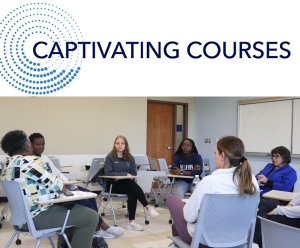With Emphasis on Communication Skills, Nursing Students Learn to Become Changemakers, Advocates for Social Justice

In the first hour of their very first “Cross Cultural Communication in Health Care” course, Villanova nursing students take part in an exercise on perception, the first of several Intergroup Relations (IGR) exercises that will teach them how to create relationships of understanding among people from different social, economic, racial and ethnic groups.
“We teach our nursing students to understand their future patients, their patients’ families, and their future colleagues in the healthcare field, and we do this by practicing careful listening and by having meaningful dialogue,” says Patricia K. Bradley, PhD, RN, FAAN associate professor at Villanova’s M. Louise Fitzpatrick College of Nursing, and co-teacher of the course. “Our students choose this course to learn about communication with patients that are of different cultures.”
The course is a 7-week senior seminar that provides an intensive opportunity for the students to reflect on issues and trends in healthcare relating to social justice and oppression. It is designed to be an intimate one, usually with 12 or fewer students. The students do reflective journaling and their assignments are reflective of their class discussions, readings and videos.
“Our students come to the course wanting to know how to interact with patients, but they don’t expect that from their first class we will be looking at cultural differences through a social justice lens,” says Bradley.
Prior to any of their course readings, the students share in a journal what they think about culture and identity. At the end of the course, they have a chance to consider how their understanding may have changed.
Sherry Perlmutter Bowen, PhD, who co-teaches the course with Bradley is an associate professor of communication. She directs the University-wide IGR program, offered through the Office of Diversity, Equity, and Inclusion and Department of Communication.
In the classroom, the desks are arranged in a circle so the group can have intimate conversations about their thoughts, feelings and behaviors. The classes reflect different social, economic, racial and ethnic groups. The set-up of the room supports the dialogue process and team atmosphere the faculty are trying to encourage.
“What we’re doing is teaching professional nursing values. Our goal is to help students learn advocacy and learn how to implement change,” says Bradley.
Senior Anna Allocco took the Cross Cultural Communication in Health Care seminar because of an interest in healthcare stemming from a medical issue she had when she was young. She describes a class activity and discussion about how each student has seen, experienced or engaged in discrimination or power privilege. “It got very personal, and it makes you really look at yourself and reflect on your thoughts, attitudes and behaviors and how they might influence your interaction with patients.”
The discussions were often about marginalization, privilege, power and social justice. “We had the ability to guide our own conversation, and if the entire group of students thought one way and one person thought differently, that was okay,” said Allocco.
There is a rule that nothing said in the classroom leaves the room, which encourages students to share and learn about each other’s experiences. “It really hits home when one of your fellow classmates, whom you’ve known for three years, shares something that’s happened to them,” says Allocco.
As part of the course, the nursing students discuss situations they see in the hospitals regarding who on a staff has more power, and how people get power in society.
“We’ve become used to these different norms, so that’s often the way people think things are going to be,” Allocco says. “For example, people often view male doctors as a more knowledgeable person to talk to, or they view an older nurse as one with more power than a younger nurse.”
The students realized that many of these issues are rooted in society and that they can be the ones to break away from the mold, identify the fact that this is going on and acknowledge that it can be discussed.
“If you realize something is going on, you have the power to ask people if they’ve thought about it in a different way,” she says.
